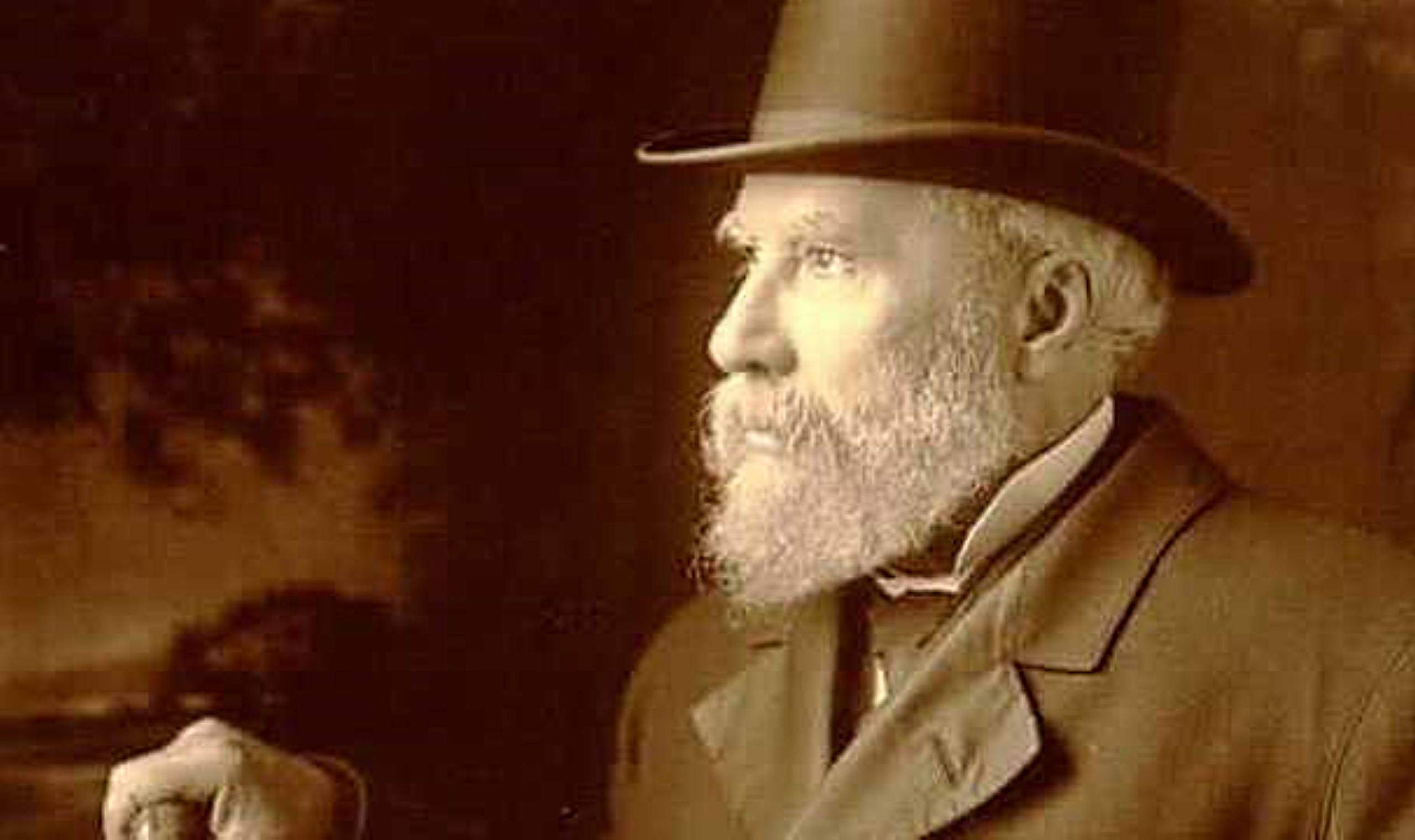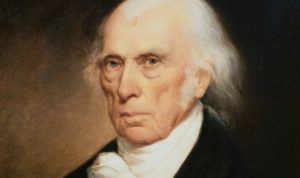Toward the end of the 19th century, James J. Hill built the Great Northern Railroad across the American Northwest. This remarkable railroad transformed that barren land—labeled the “American Desert” on maps of the day—into a vibrant, productive region. Even more remarkable than the railroad, however, is how Hill built it.
Hill was born in 1838 on a farm in Ontario, Canada. When he was fourteen, his father died suddenly and Hill went to work in a general store, where he learned much about what farmers in that cold but fertile region of Canada needed in order to produce their goods. A few years later, armed with this knowledge and just four years of formal schooling, the young Hill set out to make his fortune.
In the summer of 1856, he arrived in St. Paul, Minnesota, a city situated on high bluffs at the end of the navigable section of the Mississippi River where the Falls of St. Anthony prevent the movement of boats upstream. As such, the city became the terminus for steamboat traffic on the Mississippi and an increasingly popular destination. In 1849, eighty-five steamboats plied the river to St. Paul; when Hill arrived in 1856, more than eight hundred steamboats were making their way there each year.1 The reason for the increased steamboat traffic to St. Paul was the bounty of the Red River Valley to the north. The bottom of an ancient glacier lake, the Red River Valley is covered with the most fertile soil in the world, and in the mid-1800s its creature-rich forests provided an abundant supply of fur.
Although the high bluffs provide St. Paul protection from seasonal flooding, they made it difficult to transfer goods from the river to the city. Agile young men had to move freight from the steamboats down narrow planks to the riverbank and then manually hoist it onto horse-drawn wagons that would then climb the slippery embankment, risking accident and damage. Taking note of the scene as he stepped off the boat, Hill became an independent shipping agent on the spot.
As a shipping agent, he was responsible for moving goods from ship to shore and for paying boatmen for the transportation costs of the goods delivered. At the frontier in Minnesota, all the goods needed for living had to be shipped in from elsewhere: nails, groceries, salt, plows, harnesses, saddles, sewing needles, books, and so forth. These goods passed through many hands in transit, and at each transfer point shipping costs mounted. As shipping agents managed and tracked the flow of goods, they would pay for the prior leg of shipping and tack on new charges to cover their own costs, which would then be paid by the next agent, and so on. As a shipping agent, Hill not only came to appreciate the value of the goods exchanged; he also became keenly aware of the costs of transportation.
Hill realized that transportation costs often amounted to more than the cost of goods being transported. For example, from a shipping receipt in 1864 Hill noted that it cost $1,200 to ship 560 barrels of salt from Milwaukee to St. Paul, even though the cost of the salt itself was only $1,000. Of the transportation cost, $400 covered shipment by rail from Milwaukee due west to the Mississippi River town of Prairie du Chien, Wisconsin, and the remaining $800 covered steamboat passage up the Mississippi to St. Paul. Knowing that the distances of rail and steamboat legs of the journey were roughly the same, Hill also realized that railroad transportation was cheaper than steamboat transportation, in part because no reliable railroad had been built to compete with the steamboats.2
To earn more business, Hill lowered his own charges, noticeably reducing the shippers’ exorbitant transportation costs while raising his profits through increased volume. A quick success on his own, Hill was soon hired as the shipping agent for the Davidson Steamboat line, a position in which he set the shipping rates for goods throughout the line. As he had done on his own, Hill reduced rates to increase volume, and the Davidson line thrived as more and more businesses took advantage of the bargain. This strategy of low prices and high volume would become a mainstay of Hill’s business practices.
In 1866, Hill started his own company and made a substantial improvement to the transportation network in St. Paul. He leased property between the terminals of two railroads—the Milwaukee Railroad heading north from Chicago, and the St. Paul & Pacific heading northwest toward Canada—and built there a warehouse with an elevator. The elevator eliminated the dangerous transfer of goods up the slippery bluffs, and the warehouse provided an easier and more secure way to transfer goods from boat to dock along with extra storage space in which to protect the goods from weather while awaiting transfer. In May 1866, the St. Paul Pioneer & Democrat wrote of Hill’s achievement:
The levee was a busy scene yesterday. Several boats from above were unloading, and the levee was crowded with grain and merchandise. The splendid freight transfer house of J.J. Hill greatly facilitates business. It gives in effect just so much more levee room. A boat can be unloaded and a tremendous quantity of freight stored away there, without any confusion or crowding. Both the steamboatmen and mercantile public vote it a big thing.3
In 1872, Hill expanded his business interests by establishing a steamboat line on the Red River. Together with former St. Paul mayor and Hudson Bay Company fur trader Norman Kittson, he formed the Red River Transportation Company. Hill and Kittson then bought two Mississippi River steamboats, disassembled them, packed them on ox carts, and drove them across the prairie for reassembly and use on the Red River. The sight of steamboat parts tottering on overloaded carts across the prairie caused the press to proclaim the venture “Hill’s Folly.” Yet Hill and Kittson successfully put their boats into service on the Red River and earned back their investment in the first year.
Despite these successes, Hill believed that the transportation system that would provide the most value to the region would be a railroad linking the fertile Red River Valley to the mighty Mississippi. Actually, a railroad of sorts was there, the ambitiously named St. Paul and Pacific (St.P&P), but it was incomplete and unreliable. Originally chartered in 1857 as a land-grant railroad to connect St. Paul to Winnipeg, only half of its tracks were completed. Under the land-grant system, the U.S. government sought to develop the nation’s infrastructure by granting the railroads rights-of-way, along with ten square miles of land for every mile of track built. To retain their rights-of-way and land grants, all the railroads had to do was build their lines by a deadline set by the state legislature. However, most land-grant railroad companies were not out to build a quality transportation system, but to profit from selling the land granted them by the government. Consequently, these railroads were often cheaply built and unreliable. Such was the case with St.P&P, whose distant Dutch owners sought quick profits by selling the land around its completed lines.
In 1873, the United States suffered a severe economic depression. Like many other railroads, the St.P&P went bankrupt, providing Hill and Kittson with an opportunity.
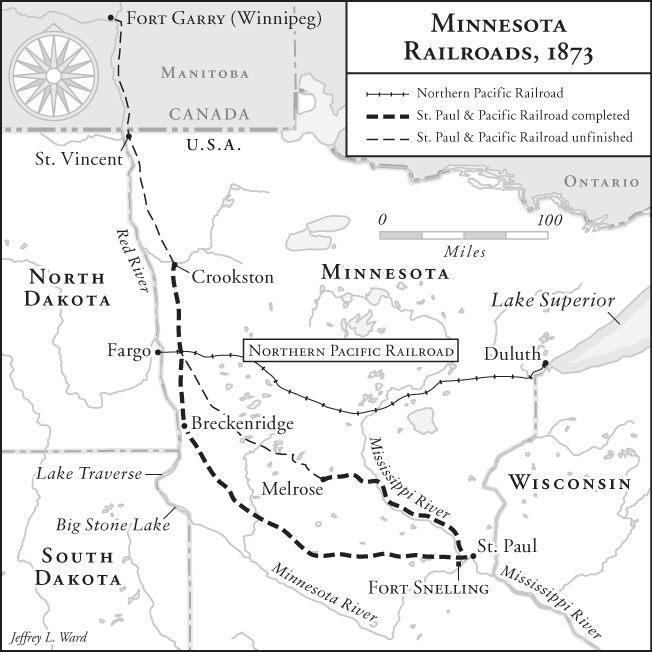
Together with another Hudson Bay Company businessman, Donald Smith, they approached the president of the Bank of Montreal, George Stephen, and formed a group called “the Associates” to buy the St. Paul. Hill and Kittson had ridden the St. Paul’s trains many times, and Hill had worked in his riverside warehouse beside the train terminal for several years. With a mind to purchase the railroad, Hill traveled it some more, quietly inspecting every facet along the way. Using his detailed, first-hand knowledge and Stephen’s financial expertise, the Associates estimated the value of the railroad assets at about $19 million.4
Hill met with Wall Street financier John S. Kennedy, who had been approached by the Dutch owners to find a buyer. (Kennedy later found another man to represent the Dutch owners, and joined the Associates.) The distant owners, unaware of the Associates’ valuation of their railroad property, were anxious about their prospects for selling it. In January 1878, the Associates offered the Dutch owners $3.8 million for the railroad. While awaiting their response, Hill asked for and received an extension from the Minnesota legislature for completing the St. Paul lines.
Hill and the Associates, unlike the railroads participating in the land-grant system, were not seeking to profit from selling government-granted land. They wanted to profit from building and operating railroad transportation. Hill’s detractors often dismiss his achievement by claiming that he was the recipient of government aid in the form of the extremely inexpensive land grant that accompanied his purchase of the St. Paul line. Indeed, the purchase of the St. Paul line included 2,643,482 acres granted the line by the Minnesota Legislature worth, according to a government pricing system, $6.7 million.5 But the Associates did not request these land grants; the land merely accompanied the St.P&P property that the Associates sought to purchase, improve, and profit from.
While contemplating buying the St. Paul & Pacific in 1876, Hill wrote to a trusted colleague:
It is difficult to estimate the increase of earnings, however, we believe that $600,000 per year would be a low estimate and with fair average crops the net earnings would undoubtedly reach $700,000 or $800,000 which amount will increase from year to year as the country is settled up.6
Hill recognized the potential of the Red River Valley and knew that the Mississippi River corridor was providing an ever-increasing stream of people to the Northwest. He also understood that whereas he could profit only once from a land sale, he could profit continually from landowners who turned the rich soil and raw materials of the Valley into goods and brought those goods to market via his reliable railroad.
Compare Hill’s vision with the spectacle of the vaunted Union Pacific, the first completed transcontinental railroad. The Union Pacific went bankrupt in 1872 within the first three years of its completion and again in 1893 because it was built cheaply for the purpose of selling land to hapless buyers who trusted that the government scheme would provide them with reliable transportation.7
Without a reliable transportation system in place to bring goods to market, the St.P&P land was worthless to those who might otherwise farm it. Recognizing the worthlessness of the land under St.P&P management, and oblivious to its potential value with a well-run railroad in place, the London financial market refused to provide any more funds to the Associates to purchase the land at the higher price sought by the Dutch owners. With this judgment from the financial markets, the owners decided it was time to cut their losses and sell the property to the only willing buyer. In June of 1878, they accepted the Associates’ offer of $3.8 million.8
The Associates were now in the railroad business. George Stephen was made the railroad’s president and Hill its general manager. Stephen operated in the East, New York and Montreal, where he used the known value of the railroad, $19 million, to finance loans for the purchase of rail and rolling stock for the line.
Hill was a hands-on manager. The first thing he did was to enact his low price/high volume strategy, slashing his rates to half those of his competitor, the Northern Pacific. He then set out to thoroughly examine his railroad with an eye toward making improvements wherever possible. By locomotive, handcar, and horse, Hill traveled the line inspecting everything, asking questions of and arguing with his engineers and track foremen, and demanding from his new employees their best effort. No detail was too small for Hill’s attention. He often delayed opening new routes until he himself had inspected the grade and curves.9 Hill knew that once a route is established, fixing it is disruptive and costly, so he strove to build his railroad correctly the first time.
The following story indicates the extent of Hill’s dedication and demanding nature.
During a sizable blizzard Hill came out in his special car to where the crew of us was trying to clear the line. He didn’t stay in his car either. He grabbed my shovel and started tossing snow, telling me to go back to his car and I’d find a pot of coffee there. I did, and spent half an hour drinking coffee and resting. Mr. Hill spelled off the one man, then another. My but he was tough! He must have shoveled snow two or three hours that day.
It has been told of Jim Hill that he knew all of his superintendents and chief foremen by name. Hell, he even knew the first name of all the older shovel-stiffs! He cursed us impartially when things went wrong, or when we weren’t working fast enough to suit him. He was obviously a man who was used to having his own way. When he didn’t, he got hot under the collar, and I’m telling you that he wore a powerfully big collar.10
While building his railroad, Hill simultaneously sought farmers to develop the Red River Valley and fill his trains with goods. He sent agents to northern Europe to recruit immigrants accustomed to climates similar to that of the American Northwest, and he created a 4,700-acre experiment farm through which to determine the best crops and animals for the climate and conditions. In two years he raised 156 prize bulls and freely distributed them to farmers in thirty counties in Minnesota and the Dakotas.11 Hill recognized that what was good for his railroad customers’ businesses would be good for his.
In 1883, Hill began his campaign to take his railroad to the Pacific. He sought and secured right-of-way concessions in the northern Dakota Territory to build his Manitoba line as far west as Devil’s Lake. But farmers and ranchers ventured even beyond Devil’s Lake, knowing that they could count on Hill to get their goods to market.
In 1884, Hill traveled to Great Falls, Montana, nearly six hundred miles from Devil’s Lake, to meet a former miller from Minneapolis who promoted the great potential of the area. With the raging falls of the northern Missouri River and the abundant coal mines nearby in Butte, Great Falls had all the ingredients—save one—to become the great smelting center of the eastern ore-laden Rockies. The missing ingredient was a railroad to haul the ore from the mineral-rich Butte region (an area also laden with gold, silver, copper, and lead mines) to Great Falls. Although the Northern Pacific Railroad passed just north of Butte on its way to the Pacific, it was yet another chartered land-grant railroad whose principals, focused on the short-term gains of land sales, failed to develop its potential. Hill saw the opportunity at hand and set out to seize it.
By linking Butte and Great Falls through St. Paul to the east, Hill could ensure that plenty of goods moved both ways on his railroad without having to reach the Pacific. But this path to Great Falls would have to run through newly established Indian reservations north of the Missouri River, which would require new treaties with the recently relocated Indians. Montana politicians assured Hill that treaties could be had and set out to arrange for them.
Meanwhile, Hill established the Montana Central Railway as an independent, stand-alone company whose sole purpose was to connect the mineral-rich region of Butte with the smelting center of Great Falls. This limited the risk on the part of the investors in the Manitoba extension and further demonstrated to Montana politicians that Hill was serious about developing the region, thereby motivating them to do their utmost to gain rights-of-way through the reservations.
Early in 1886, Hill secretly presented the Manitoba Board with a plan that showed the line’s possible, probable, and actual routes, and an option to buy the Montana Central.12 He also paid high prices and tariffs to purchase steel and other building supplies from companies overseas, including England and Germany, because ordering from American companies risked his plans being made public.
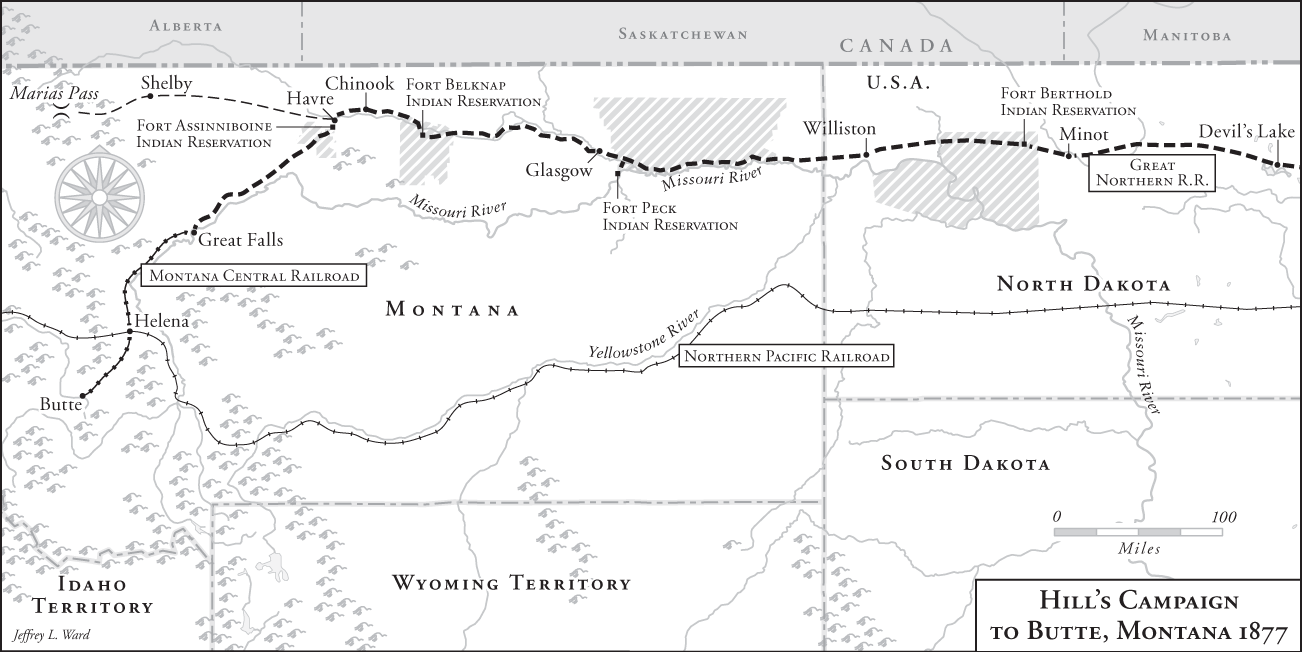
During the building season of 1886, Hill extended the Manitoba line from Devil’s Lake another 117 miles to Minot, North Dakota. He also laid the Montana Central roadbed between Butte and Great Falls but would not lay the rail, refusing to pay the Northern Pacific’s exorbitant rates to ship rail to Helena, Montana, where that railroad passed on its way to the Pacific. After the harvest season, Hill dedicated every railroad engine and flatbed on his line to hauling building materials to Minot for the westward expansion of the Manitoba line. In October of that year, he sent a private telegram to John S. Kennedy explaining his intentions:
We must build 783 miles of road next summer in eight months from the present end of the track to Montana to insure our position of advantage. This all has to be done from one end and is more track than has ever been laid in ten months elsewhere, over twice this year’s work which has been carried on at four places, and will take a hundred million feet of timber and ties.13
But his intentions were clear to others as well. Hill had laid a roadbed in Montana and was building the Manitoba line in the direction of that state while amassing a huge stock of building supplies at the line’s end. Farmers moved with the railroad to Minot in anticipation of Hill’s expansion and planned for first harvests during the 1887 growing season. Further, skilled rail-laying Irish teams who had just finished his extension to Minot waited in the Northwest, confident that Hill would call on them to extend his line even farther. All that was needed now was permission from the Indians to extend the Manitoba line through their reservations. In early 1887, permission was granted, and Hill’s great leap across the prairie began.
By April 1887, 8,000 graders—mostly local farmers—with 6,600 horses started grading the railroad’s path and laying its roadbed. They built an average of one hundred miles a month and covered two hundred miles in the final month of the building season. The Irish rail teams quickly followed suit, laying 3,000 oak ties and more than 100 tons of rail per mile.14 Charles Dudley Warner, a witness of this effort remarked: “Those who [see] this army of men and teams stretching over the prairie and casting up this continental highway think they behold one of the most striking achievements of civilization.”15
Hill pushed himself to the brink of exhaustion running back and forth along the line, supervising its construction. In New York, Kennedy busily sold bonds to fund the great prairie effort, which could be financed only at the last minute, after permission was granted to build through the Indian reservations. As the bills were mounting from the front, the Manitoba Board grew uneasy.
Hill had planned to put down 783 miles of track in one building season, but the farmers asked for additional spurs and extensions to support the various harvests they had planted near the line. Although Hill had planned for some extensions, he had not anticipated this much demand. But, as he saw it, these farmers had come to the Northwest because of the promise of his line. They had farmed the Red River Valley and turned it into the breadbasket of North America because he had encouraged them to do so. Further, their grain and livestock were the staples shipped on Hill’s trains—and these same men had graded the roadbeds for his rail. Hill could not leave them in the lurch. So he built an additional 167 miles of spurs and extensions, thus expanding the project more than 20 percent beyond the original plan. Remarkably, despite the expansion, he made it to Great Falls by October and then to Helena before the first snows. Hill and his team of men laid an incredible 940 miles of railroad in one building season.16
Back in New York, however, members of the Manitoba Board—including Kennedy—thought “the expansion program is out of hand,” and demanded an explanation. So, in January 1888, Hill traveled to New York for a meeting, in which Kennedy proposed that the Associates cut their losses by combining the Manitoba line with other companies and selling the lot. George Stephen recalled that Hill “locked the door and served notice that they may vote on the plan [to sell out], but that would be as near as they would ever come in carrying it into effect.”17 Kennedy’s proposal was rejected, and Hill returned to the Midwest and resumed his work—which consisted of still further expansion.
After his earlier experience with the Northern Pacific trying to charge him exorbitant rates for a rail shipment from Chicago to Montana, Hill concluded that he should not rely on competing railroads. So, in Minnesota, Hill purchased existing railroads to connect St. Paul to the Great Lakes. He also purchased a Great Lakes shipping line, which gave him unfettered access to the East’s steel mills as well as more capability to move the ores and metals mined and smelted in Montana back to the East.
On the western front, Hill sent teams of explorers to find the best path through the Rockies for the railroad. In particular, his teams were searching for the legendary Marias Pass, which, according to Indian legend, was the lowest pass in all of the Rockies. One of Hill’s engineers, John Stevens, found the pass at an altitude of 5,214 feet, some 200 feet lower than the previous lowest-known pass in the Rockies. By finding and securing use of the Marias Pass, Hill ensured that his railroad would enjoy an enduring competitive advantage over other railroads transiting the Rockies. Hill’s trains would always expend substantially less energy crossing the mountains and thus be able to charge lower rates for transporting goods from the Great Lakes to the Pacific.18
The Cascade Mountains were the last great barrier to Hill’s dream of a transcontinental railroad. Unsurprisingly, Hill again placed John Stevens in charge of finding the best path through the mountains. To the east, while Stevens searched, Hill moved his staging point for the Pacific expansion from Great Falls, Montana, back to Havre, Montana. To the west, Hill’s agents bought property in several Puget Sound cities in order to keep politicians and land speculators guessing where Hill would run his railroad.
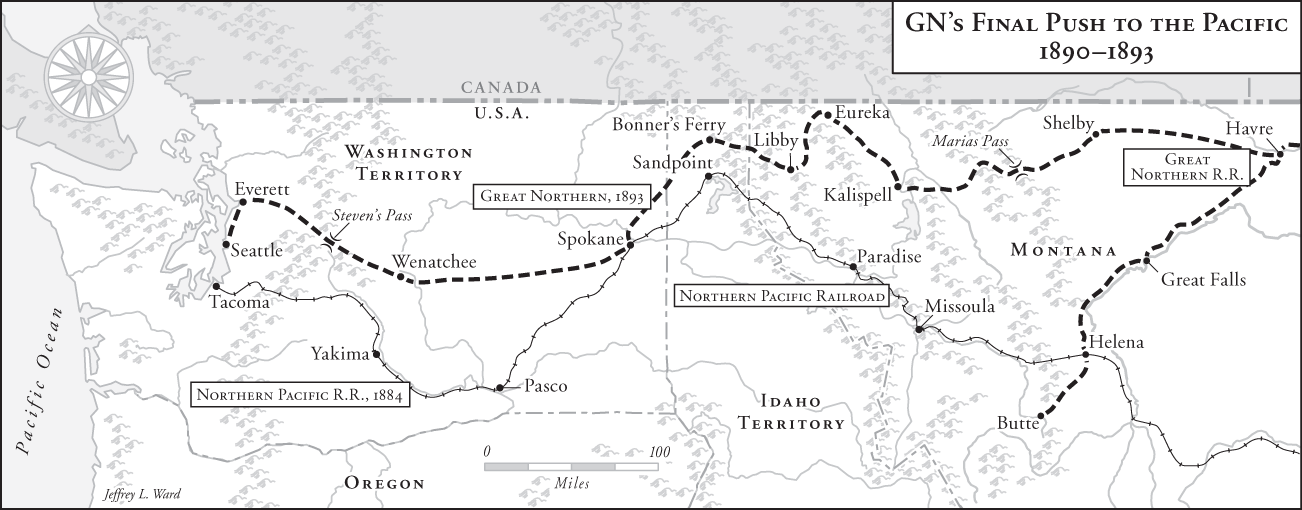
Once Stevens’ path through the Cascades was approved, Hill found funding in the reluctant European financial markets to begin his final push to the Pacific. At this time he combined the Manitoba Railroad with other properties and railroads and rechristened the line “the Great Northern.”
In the fall of 1890, Hill began laying track from Havre, Montana, westward through the Rockies. In the spring of 1892, with Stevens in the lead, the Great Northern started building eastward from the Puget Sound port of Everett, Washington, to the pass named after Stevens in the Cascade Mountains. The westward extension from Montana reached Spokane, Washington, in June of 1892 and Stevens Pass soon thereafter.
Hill expected the line to be completed by fall, but he soon received a wire from Stevens saying that that deadline was impossible. Hill sped to Washington, where Stevens showed him the treacherous pass and pointed out that, in order to meet Hill’s high standards of safety, they would have to build a tunnel, which would delay completion of the line for eight years. That delay was unacceptable to Hill, so he asked Stevens to complete the line via the pass in the safest manner possible. Stevens proceeded and, on January 8, 1893, over the westward side of the mountain at Scenic, Washington, and 1,727 miles from St. Paul, the Pacific Extension was completed, and Hill’s transcontinental railroad became a reality.
Hill later expanded the Great Northern to its final terminal in Seattle. In order to have something to ship back on his trains from the Washington Territory, Hill asked his lumberman neighbor in St. Paul to inspect the forests of the Cascade Mountains. At first, Frederick Weyerhaeuser declined. But Hill persisted, and soon the Great Northern trains were heading back east to the treeless prairie states and beyond loaded with Weyerhaeuser lumber—an arrangement that continues to this day.
Hill also invested his own money in irrigation systems for farms and orchards in Washington, and continued to give away prize bulls and seed to farmers and ranchers all along his railroad. Four states—North Dakota, Montana, Idaho, and Washington—were largely settled by immigrants who arrived via Hill’s railroad. These settlers affectionately called Hill the “Empire Builder.”19 It was a well-earned title.
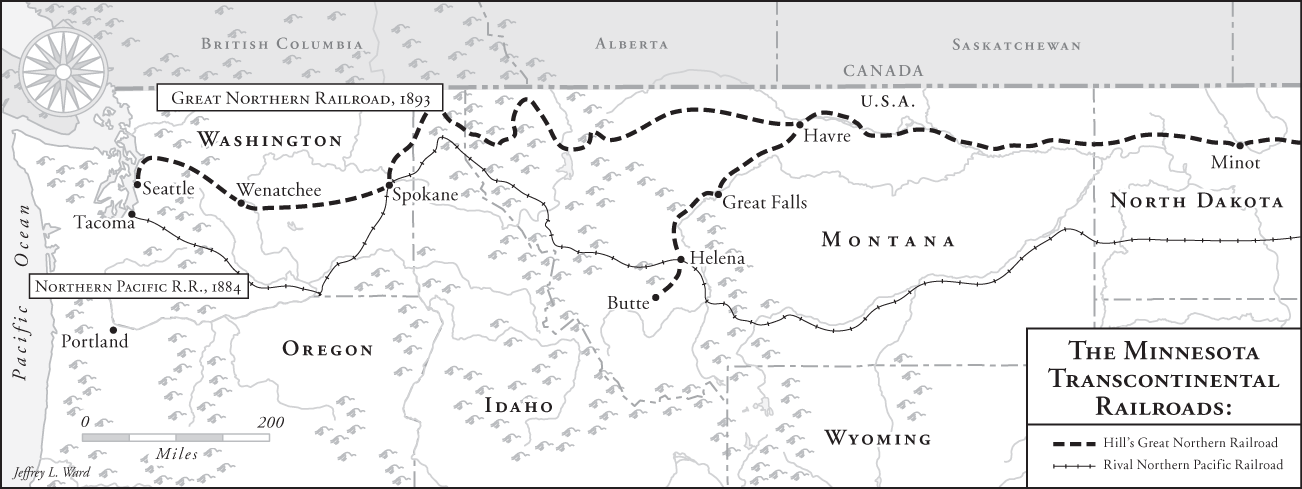
From his start in America with virtually nothing, Hill built a transcontinental railroad—without a nickel of government money—by thinking, producing, persisting, and trading value for value every step of the way. He thereby created not only a vital railroad that serves the world to this day but also a vivid example of what is possible to a man of virtue.
You might also like
Endnotes
1 Albro Martin, James J. Hill and the Opening of the Northwest (New York: Oxford Press, 1976), p. 34.
2 Martin, James J. Hill,p. 38.
[groups_can capability="access_html"]
3 St. Paul Pioneer & Democrat, May 17, 1866.
4 Ralph W. Hidy, Muriel E. Hidy, Roy V. Scott, and Don L. Hofsommer, The Great Northern Railway, A History (Minneapolis: University of Minnesota Press, 2004), p. 30.
5 U.S. Statutes at Large 195, “An Act Making a Grant of Land to the Territory of Minnesota in alternate sections, to and in the construction of certain railroad in said Territory”; Territorial Laws of Minnesota, ch. 1, Act approved May 22, 1857.
6 Martin, James J. Hill,p. 131.
7 Union Pacific website, http://www.uprr.com/aboutup/history/uprr-chr.shtml.
8 Hidy et al., Great Northern Railway, p. 31.
9 Stewart Holbrook, The Story of American Railroads (New York: Crown Publishers, 1947), p. 177.
10 Holbrook, Story of American Railroads,p. 179.
11 Joseph Gilpin Pyle, The Life of James J. Hill, vol. 1 (New York: Doubleday, Page & Company, 1917), p. 370.
12 Hidy et al., Great Northern Railway, p. 57.
13 Martin, James J. Hill,p. 344.
14 Hidy et al., Great Northern Railway, p. 59.
15 Charles Dudley Warner, “Studies of the Great West,” Harper’s Magazine, vol. 76 (March 1888), p. 564.
16 Hidy et al., Great Northern Railway, p. 61.
17 Hidy et al., Great Northern Railway, p. 69.
18 Hidy et al., Great Northern Railway, p. 192.
19 Holbrook, Story of American Railroads,p. 187.
[/groups_can]



